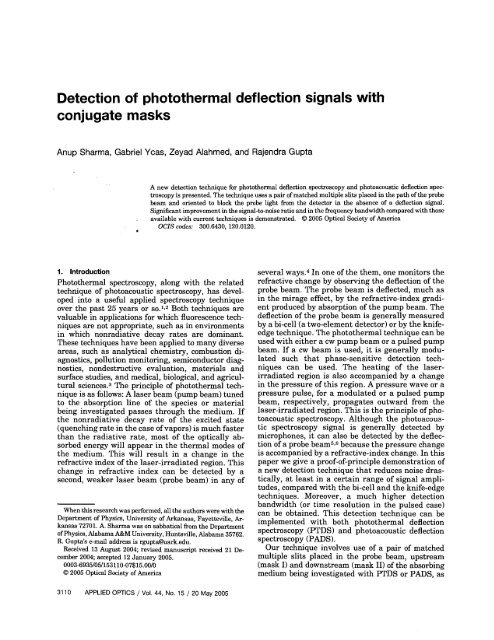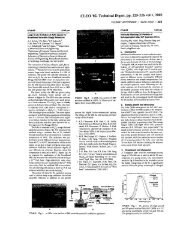Rajendra Gupta - Physics - University of Arkansas
Rajendra Gupta - Physics - University of Arkansas
Rajendra Gupta - Physics - University of Arkansas
You also want an ePaper? Increase the reach of your titles
YUMPU automatically turns print PDFs into web optimized ePapers that Google loves.
Detection <strong>of</strong> photothermal deflection signals with<br />
conjugate masks<br />
Anup Sharma, Gabriel Ycas, Zeyad Alahmed, and <strong>Rajendra</strong> <strong>Gupta</strong><br />
A new detection technique for photothermal deflection spectroscopy and photoacoustic defledion spectroscopy<br />
is presented. The technique uses a pair <strong>of</strong> matched multiple slits placed in the path <strong>of</strong> the probe<br />
beam and oriented to block the probe light from the detector in the absence <strong>of</strong> a deflection signal.<br />
Significant improvement in the signal-to-noise ratio and in the frequency bandwidth compared with those<br />
: available with current techniques is demonstrated. O 2005 Optical Society <strong>of</strong> America<br />
OCZS codes: 300.6430, 120.0120.<br />
t<br />
1. Introduction<br />
Photothermal spectroscopy, along with the related<br />
technique <strong>of</strong> photoacoustic spectroscopy, has developed<br />
into a useful applied spectroscopy technique<br />
over the past 25 years or so.l,"oth techniques are<br />
valuable in applications for which fluorescence techniques<br />
are not appropriate, such as in environments<br />
in which nonradiative decay rates are dominant.<br />
These techniques have been applied to many diverse<br />
areas, such as analytical chemistry, combustion diagnostics,<br />
pollution monitoring, semiconductor diagnostics,<br />
nondestructive evaluation, materials and<br />
surface studies, and medical, biological, and agricultural<br />
sciences."e principle <strong>of</strong> photothermal technique<br />
is as follows: A laser beam (pump beam) tuned<br />
to the absorption line <strong>of</strong> the species or material<br />
being investigated passes through the medium. If<br />
the nonradiative decay rate <strong>of</strong> the excited state<br />
(quenching rate in the case <strong>of</strong> vapors) is much faster<br />
than the radiative rate, most <strong>of</strong> the optically absorbed<br />
energy will appear in the thermal modes <strong>of</strong><br />
the medium. This will result in a change in the<br />
refractive index <strong>of</strong> the laser-irradiated region. This<br />
change in refractive index can be detected by a<br />
second, weaker laser beam (probe beam) in any <strong>of</strong><br />
When this research was performed, all the authors were with the<br />
Department <strong>of</strong> <strong>Physics</strong>, <strong>University</strong> <strong>of</strong> <strong>Arkansas</strong>, Fayetteville, <strong>Arkansas</strong><br />
72701. A. Sharma was on sabbatical from the Department<br />
<strong>of</strong> <strong>Physics</strong>, Alabama A&M <strong>University</strong>, Huntsville, Alabama 35762.<br />
R. <strong>Gupta</strong>'s e-mail address is rgupta@uark.edu.<br />
Received 13 August 2004; revised manuscript received 21 December<br />
2004; accepted 12 January 2005.<br />
0003-6935/05/153110-07$15.00/0<br />
O 2005 Optical Society <strong>of</strong> America<br />
several ways.4 In one <strong>of</strong> the them, one monitors the<br />
refractive change by obsewing the deflection <strong>of</strong> the<br />
robe beam. The robe beam is deflected. much as<br />
in the mirage effict, by the refractive-index gradient<br />
produced by absorption <strong>of</strong> the pump beam. The<br />
deflection <strong>of</strong> the probe beam is generally measured<br />
by a bi-cell (a two-element detector) or by the knifeedge<br />
technique. The photothermal technique can be<br />
used with either a cw pump beam or a pulsed pump<br />
beam. If a cw beam is used, it is generally modulated<br />
such that phase-sensitive detection techniques<br />
can be used. The heating <strong>of</strong> the laserirradiated<br />
region is also accompanied by a change<br />
in the pressure <strong>of</strong> this region. A pressure wave or a<br />
pressure pulse, for a modulated or a pulsed pump<br />
beam, respectively, propagates outward from the<br />
laser-irradiated region. This is the principle <strong>of</strong> photoacoustic<br />
spectroscopy. Although the photoacoustic<br />
spectroscopy signal is generally detected by<br />
microphones, it can also be detected by the deflection<br />
<strong>of</strong> a probe beam5.6 because the pressure change<br />
is accompanied by a refractive-index change. In this<br />
paper we give a pro<strong>of</strong>-<strong>of</strong>-principle demonstration <strong>of</strong><br />
a new detection technique that reduces noise drastically,<br />
at least in a certain range <strong>of</strong> signal amplitudes,<br />
compared with the bi-cell and the knife-edge<br />
techniques. Moreover, a much higher detection<br />
bandwidth (or time resolution in the pulsed case)<br />
can be obtained. This detection technique can be<br />
implemented with both photothermal deflection<br />
spectroscopy (PTDS) and photoacoustic deflection<br />
spectroscopy (PADS).<br />
Our technique involves use <strong>of</strong> a pair <strong>of</strong> matched<br />
multiple slits placed in the probe beam, upstream<br />
(mask I) and downstream (mask 11) <strong>of</strong> the absorbing<br />
medium being investigated with FTDS or PADS, as<br />
31 10 APPLIED OPTICS / Vol. 44, No. 15 / 20 May 2005
2. ALAHMED<br />
R. G UPTA~<br />
Theory <strong>of</strong> two-photon photothermal deflection<br />
spectroscopy in stationary and flowing media<br />
for arbitrary optical pulse length<br />
Unlverslty <strong>of</strong> <strong>Arkansas</strong>, Fayetteville, AR 72701, USA<br />
Received: 21 May 2004/Revised version: 6 July 2004<br />
Published online: 25 August 2004 O Springer-Verlag 2004<br />
ABSTRACT A general theory <strong>of</strong> pulsed two-photon phototherma1<br />
dcflection spectroscopy (PTDS) is presented. We find that<br />
there are significant enough differences in the amplitude and<br />
temporal evolution <strong>of</strong> PTDS signals between the results <strong>of</strong> the<br />
single- and two-photon theories that if one tries to interpret twophoton<br />
data with single-photon theory, the extracted values may<br />
be considerably in error. Our theory is sufliciently general that<br />
it incorporates both stationary and flowing media and considers<br />
optical pulses <strong>of</strong> arbitrary length. Moreover, the temporal pr<strong>of</strong>ile<br />
<strong>of</strong> the optical pulse is explicitly taken into account. The twophoton<br />
absorption coefficient is explicitly expressed in terms <strong>of</strong><br />
oscillator strengths and Clebsch-Cordan coefficients, and the<br />
Doppler width for both co-propagating and co~nter-~ro~a~ating<br />
beams is taken into account. Although the theory is primarily<br />
developed for atomic and molecular vapors, it can easily be<br />
adapted for condensed matter by expressing the absorption coefficient<br />
in terms <strong>of</strong> the properties <strong>of</strong> the liquid or solid under<br />
investigation.<br />
PACS 82.80.Kq; 42.62.Fi; 39.30.+w<br />
1 Introduction<br />
Over the past two decades photothermal spectroscopy<br />
has developed into one <strong>of</strong> the major applied spectroscopic<br />
techniques. The technique has been applied to<br />
many diverse areas, such as analytical chemistry, semiconductor<br />
diagnostics, non-destructive evaluation, materials and<br />
surface studies, and medical, biological, and agricultural<br />
sciences, to name just a few [I]. Basically, photothermal<br />
spectroscopy and its sister technique, photoacoustic spectroscopy<br />
111, arc used whcn fluorcsccncc tcchniques are<br />
inappropriate. In this article, we present a systematic and<br />
comprehensive study <strong>of</strong> the theory <strong>of</strong> two-photon phototherma1<br />
dcflcction spcctroscopy (PTDS), which will cxtcnd thc<br />
range <strong>of</strong> applications <strong>of</strong> PTDS considerably. For example,<br />
the theory presented in this paper will enable quantitative analysis<br />
<strong>of</strong> two-photon PTDS signals obtained from species,<br />
such as atomic hydrogen and oxygen, in a combustion environment<br />
or in a reacting atmospheric-pressure plasma.<br />
E3 Fax: +I-4791575-4580, E-mail: rgupta@uark.edu<br />
Although this theory is primarily developed for atomic<br />
and molecular vapors, it is also applicable to liquids and<br />
solids.<br />
The principle <strong>of</strong> the photothermal technique is as follpws:<br />
a laser beam (pump beam) tuned to the absorption line <strong>of</strong> the '<br />
species being investigated passes through the medium. If the<br />
non-radiative decay rate <strong>of</strong> the excited state (quenching rate in<br />
the case <strong>of</strong> vapors) is much faster than the radiative rate, then<br />
most <strong>of</strong> the optically absorbed energy appears in the thermal<br />
modes <strong>of</strong> the medium. This results in achange ~f t he refractive<br />
index <strong>of</strong> the laser-irradiated region. This change in refractive<br />
index can be detected by a second, weaker laser beam (probe<br />
beam) in several different ways 121. In this paper we limil<br />
ourselves to one method only, in which the refractive-index<br />
change is monitored by observing the deflection <strong>of</strong> the probe<br />
beam. The probe beam gets deflected, much like in the mirage<br />
effect, by the refractive-index gradient produced by the ab- '<br />
sorption <strong>of</strong> the pump beam. The technicye cpn he used either<br />
with a cw pump beam or a pulsed pump bean]. ~n 1.11;. piper<br />
we only consider pulsed excitation <strong>of</strong> the species, because i,<br />
is easier to obtain high peak powers required for two-photon .<br />
excitation by pulsed lasers. The amplitude <strong>of</strong> the PTDSasignal<br />
gives the concentration <strong>of</strong> the absorbing species. If ikan<br />
be assumed that almost all <strong>of</strong> the absorbed optiial energy from .<br />
the pump beam ends up in the thermal modes <strong>of</strong> the medium:<br />
then absolute concentrations can be measured without using<br />
any kind <strong>of</strong> a calibration procedure. Moreover, the thermal<br />
transport properties <strong>of</strong> the medium can be deduced froni the.<br />
temporal evolution <strong>of</strong> the PTDS signal after the laser.pulse<br />
is over. If the medium is flowing, the heated region <strong>of</strong>the<br />
medium travels downstream with the flow, which causes kde-.<br />
flection <strong>of</strong> the probe beam placed slightly downstream hpm<br />
thc pump beam. Thc timc <strong>of</strong> flight <strong>of</strong> thc hcat pulsc bctwccn<br />
thc pump and probe bcams yiclds thc flow icloclty <strong>of</strong> thc<br />
medium. In order to be able to obtain quantitative measusements<br />
<strong>of</strong> parameters such as species concentration, thefmal<br />
transport propertics, and flow vclocity from ~hc analysis 01'<br />
PTDS signals, it is necessary to have d ::::!p:~ie thc~iy a&<br />
the generation and temporal evolution <strong>of</strong> the signals. VJc 'ilavi<br />
recently demonstrated measurement <strong>of</strong> the ahsolute concentration<br />
<strong>of</strong> OH in a methane-oxygcn flamc 131, gpd a simu.itaneous<br />
measurement (from the analysis <strong>of</strong> a single data curve)<br />
<strong>of</strong> absolute OH concentration, temperature (which was de-













